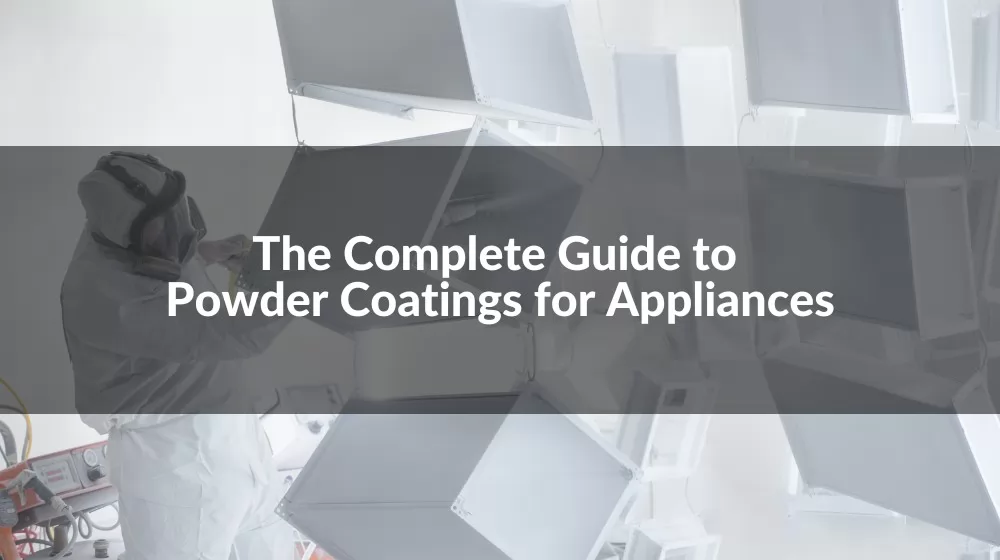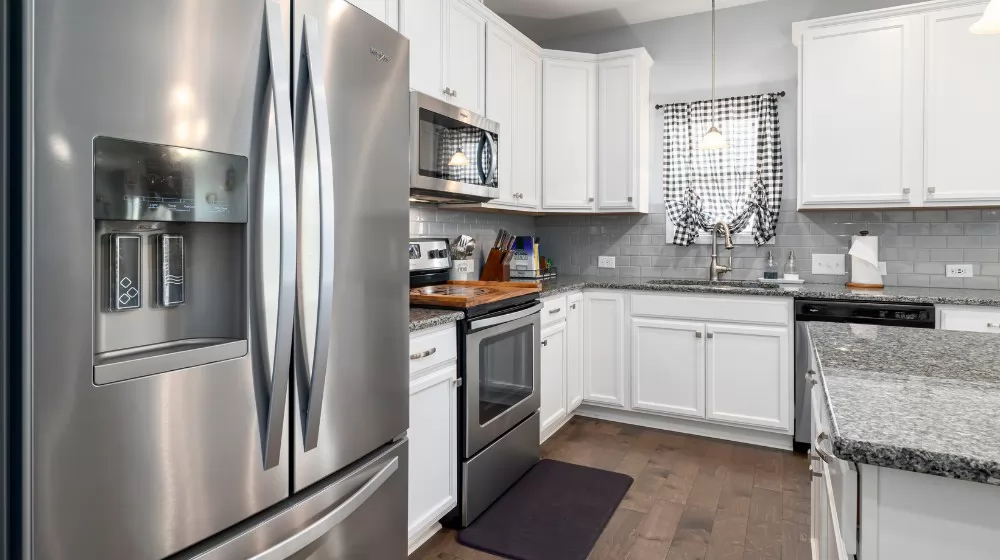
.png)
.png)


-
.png) 0086-757-85407388
0086-757-85407388 -

-
 terrychen@wintoly.com
terrychen@wintoly.com


.png)
.png)


.png)




Welcome to the definitive guide on powder coatings, a revolutionary finishing touch that transforms the functional into the phenomenal. Whether it's enhancing the durability of home appliances or elevating the aesthetics of industrial equipment, discover how the right appliance powder coating can make all the difference. Dive into the world of vibrant finishes and resilient surfaces as we explore the benefits and innovations of powder coating technology.
Ever wondered what gives your appliances that smooth, durable finish that resists scratches and corrosion? The secret lies in a remarkable process known as powder coating. This advanced technique involves applying a free-flowing, dry powder to metal surfaces—typically appliances, automotive parts, and heavy-duty machinery.
Unlike traditional wet paint, powder coatings do not require a solvent to keep the binder and filler parts in a liquid suspension form. Instead, they are applied electrostatically and are then cured under heat to form a "skin." This skin is not just any layer; it's a protective fortress that shields the appliance from the wear and tear of everyday use, making appliance powder coating a go-to choice for enhancing longevity and aesthetics.
The beauty of powder coating lies in its versatility. The range of finishes is vast—from matte to high gloss, and everything in between. Moreover, this isn't just about looks; the functional benefits are equally impressive. Powder-coated surfaces are more resistant to chipping, scratching, fading, and wearing than other finishes. This makes the method incredibly suitable for home appliance powder coating, where both functionality and appearance are paramount.
But it's not just the end result that's remarkable. The process of applying powder coating is also environmentally friendly, emitting zero or near-zero volatile organic compounds (VOCs), and nearly any overspray can be recycled, which means it's not just good for your appliances, but for the planet as well.
When it comes to selecting a coating for your appliances, the debate often boils down to two contenders: powder coatings and liquid coatings. Each has its merits and limitations, but a head-to-head comparison might just tip the scales for those in the 2B sector looking for the most efficient and durable option.
First off, let's talk about application. Liquid coatings, while traditional, require solvents that can be hazardous to the environment. They tend to have longer drying times, which can be a bottleneck in a fast-paced production environment. On the flip side, powder coatings are applied using an electrostatic process that causes the powder to adhere to the surface until cured under heat, resulting in a quicker turnaround.
Durability is another deciding factor. Liquid coatings may offer a thinner finish which can be prone to environmental degradation over time. Powder-coated appliances, however, often exhibit superior resistance to scratching, chipping, and UV rays, thanks to the thermal bonding process during curing, which makes them ideal for the wear and tear of everyday appliance use.
Aesthetically speaking, liquid coatings have been known for a wider variety of finishes and textures. Yet, the powder coating technology has rapidly evolved, now offering a comparable spectrum of color choices and finish types, including textures that mimic wood grain or marble.
Moreover, we cannot overlook the environmental and economic aspects. Liquid coatings generate volatile organic compounds (VOCs) and require careful disposal methods to mitigate their environmental impact. In contrast, powder coatings are celebrated for their minimal environmental footprint, as they contain no solvents and emit negligible VOCs, with the added advantage of recyclable overspray.
Diving into the science of powder coatings unveils a fascinating interplay of chemistry and physics. At its core, powder coating is a complex blend of polymer resin systems, pigments, curatives, leveling agents, flow modifiers, and other additives. These ingredients are meticulously mixed, melted, cooled, and ground into a uniform powder similar in texture to baking flour.
The primary component is the resin, which forms the backbone of the coating, providing the basic film-building properties and defining the mechanical attributes of the finish. Resins such as epoxy, polyester, polyurethane, and acrylics are chosen based on the desired properties of the final product—be it toughness, clarity, flexibility, or chemical resistance.
Pigments serve not only to color the coating but also to affect its opacity and protect the substrate from ultraviolet light. Curatives are crucial as they react with the resin during the curing process (baking) to form a cross-linked polymer network that is the essence of the coating’s durability.
Flow modifiers and leveling agents play a significant role in the finish of the powder coating, ensuring that the coat melts and flows out evenly over the surface before it cures. This is what gives appliance powder coating its smooth, flawless look.
The application of this fine powder onto the surface of an appliance is governed by electrostatic principles. Charged particles are attracted to the electrically grounded surfaces they are meant to adhere to, ensuring a uniform distribution before the curing process.
Upon curing, the chemical reaction called polymerization takes place. This reaction forms high molecular weight networks of polymers that are heat resistant, tough, and aesthetically pleasing. These chemical reactions are finely tuned to ensure the home appliance powder coating provides a finish that not only looks good but also stands up to the rigorous demands of daily appliance use.

In the world of powder coatings, variety is abundant. Manufacturers and consumers can choose from several types of powder coatings, each with unique properties and applications. Understanding the different types helps in selecting the perfect coating for your appliance needs.
Epoxy Powder Coatings are known for their excellent corrosion resistance and adhesion properties. They are ideal for indoor applications, offering a hard and durable finish. However, they can be prone to chalking when exposed to UV light, thus not preferred for outdoor use.
Polyester Powder Coatings are celebrated for their UV resistance and are more suitable for outdoor applications. They provide excellent mechanical resistance and maintain a high-quality finish over time, resisting the effects of prolonged sun exposure.
Acrylic Powder Coatings offer a high-gloss finish with superior weathering resistance. Their clarity and resistance to dirt pickup make them a popular choice for automotive and other exterior appliance applications.
Urethane Powder Coatings, notable for their excellent impact resistance and flexibility, are often used for items that are subject to a lot of movement or bending. They also possess good chemical resistance and are suitable for a wide range of temperatures.
Each type serves a specific purpose, whether it's the toughness and chemical resistance for a kitchen appliance or the UV stability and gloss for an outdoor grill. When it comes to home appliance powder coating, these choices ensure that no matter the appliance, there's a coating that can protect and enhance it effectively.
The aesthetic versatility of powder coatings is nearly limitless, offering a spectrum of colors and textures that can transform any appliance into a statement piece. The advancement in technology not only allows for a wide range of hues but also various effects and finishes that can mimic other materials or create a unique look.
Color Variations: From vibrant, eye-catching shades to subtle, sophisticated tones, the color options in powder coatings are extensive. Special color matching systems are in place that allows manufacturers to create custom shades, ensuring brand consistency or the ability to meet specific design requirements for appliance powder coating.
Textures: The texture in powder coatings can range from smooth surfaces to wrinkled or matte finishes, to rough textures resembling sandpaper. Textures not only add to the visual appeal but can also provide functional benefits like masking surface imperfections and increasing durability.
Special Effects: Advances in powder coating technology have led to the development of finishes that mimic natural materials like stone, wood, and marble, as well as those that offer translucency and iridescence. These special effects can give appliances a high-end look while benefiting from the durability of a powder-coated finish.
For businesses, the ability to offer a wide range of color and texture options is not just about aesthetics; it’s about providing tailored solutions for clients. Whether it's achieving a specific brand color for a line of refrigerators or offering a rugged finish on a barbecue grill for extra grip, the customizability of home appliance powder coating is a significant advantage.
In conclusion, the color and texture options in powder coatings not only enhance the visual appeal of appliances but also contribute to their functionality and consumer appeal. With such a diverse palette to choose from, manufacturers can easily align with market trends and consumer preferences, offering products that stand out in both performance and style.
Powder coatings do more than just make appliances look good; they contribute significantly to the functional performance of household and industrial equipment. This marriage of form and function—functional aesthetics—is central to modern appliance design, influencing consumer choice and satisfaction.
The aesthetic quality of an appliance often gives the first impression and can be a substantial factor in the purchasing decision. A sleek, uniform finish conveys quality and durability, while the right color can connect with consumers on an emotional level. But these coatings are not just about beauty; they offer a protective shell that extends the life of the appliance.
Durability is an inherent feature of powder-coated surfaces, defending against the dents and dings of daily use. This resilience ensures that the appliance maintains its aesthetic appeal over a longer period, thus enhancing its functional lifespan. Moreover, the ease of cleaning and maintaining these surfaces adds to their functional value.
Texture plays a role too; a rough finish can provide a non-slip grip on handles, while a smooth satin finish may signify ease of cleaning. In the realm of home appliance powder coating, the right texture can contribute to the user’s safety and the appliance’s usability.
Thermal properties are another aspect where functional aesthetics come into play. Some powder coatings are designed to withstand high temperatures, making them ideal for appliances like ovens and toasters, where both appearance and heat resistance are critical.
The hallmark of powder coatings is their superior durability and wear resistance, which stand up against the test of time and usage. In an industry where longevity and low maintenance are key, these coatings provide a robust defense against a myriad of stresses that appliances face daily.
The resilience of powder-coated surfaces is due to the cross-linked polymer structure formed during the curing process. This structure imparts a toughness that helps appliances resist scratching, peeling, and fading. Whether it's the constant opening and closing of a refrigerator door or the high heat from a stove, powder coatings maintain their integrity and appearance.
Additionally, powder coatings are less susceptible to the impacts of UV light, moisture, and chemicals. This resistance to environmental factors means that the color and finish of an appliance will not deteriorate prematurely, which is especially crucial for outdoor or heavy-use items.
In the context of home appliance powder coating, this durability translates to consumer products that can withstand the rigors of cleaning agents, cooking spills, and the abrasion from pots and pans. For manufacturers, it means fewer warranty claims and a reputation for quality.
Moreover, wear resistance is not only beneficial for the lifespan of the appliance but also for its sustainability aspect. Products that last longer reduce the need for frequent replacements, thereby contributing to waste reduction and promoting a more sustainable consumption model.
Powder coatings are integral in the manufacturing of everyday household appliances like refrigerators, washers, and dryers. These appliances benefit greatly from the coatings' durability and resistance to moisture, chemicals, and physical impacts. The sleek, hard-wearing finish of a powder-coated refrigerator resists the daily wear from constant handling and cleaning, while washers and dryers operate in high humidity and heat, environments where powder coatings excel in performance.
In commercial settings, appliances are subjected to rigorous use and frequent cleaning. Here, the powder coatings must be not only visually appealing but also robust enough to withstand the harsh conditions of commercial kitchens, laundromats, and the like. Their ability to resist scratches and corrosion ensures that commercial appliances can endure heavy usage while maintaining their functional and aesthetic qualities.
Industrial ovens and vending machines, often placed in uncontrolled environments, require a coating that can tolerate extreme temperatures and exposure to the elements. Powder coatings on industrial ovens must withstand high temperatures without degrading, while vending machines need a finish that can endure outdoor conditions without fading or chalking.
High-end appliances often feature specialty powder coatings that offer enhanced properties such as antimicrobial surfaces, increased resistance to fingerprints, and even self-healing capabilities. These coatings not only contribute to the appliance's luxury aesthetic but also provide additional functional benefits, aligning with the premium nature of these products.

Selecting the right powder coating for an appliance is crucial and should be matched to the appliance's function and the environment it will inhabit. For instance, refrigerators and freezers require coatings that can handle low temperatures and resist moisture, while ovens need high-temperature resistant coatings. Understanding the specific needs of each appliance ensures optimal performance and longevity.
When considering powder coatings, it's important to weigh long-term savings against upfront costs. While the initial setup for powder coating can be more costly than traditional liquid coatings, the durability and reduced maintenance over the lifespan of the appliance often result in greater savings down the line. Additionally, the environmental benefits can translate to reduced regulatory costs and improved brand image.
Choosing a reputable powder coating supplier involves several considerations. Key factors include the supplier's ability to provide the desired finish, their compliance with industry and environmental standards, and their track record for quality and reliability. It's also wise to assess their level of customer service and technical support, ensuring a valuable partnership.
When it comes to selecting a leader in the realm of powder coatings, look no further than Wintoly, China's premier manufacturer. Our cutting-edge solutions and commitment to quality stand testament to our position at the forefront of the industry. For the ultimate in durability, aesthetics, and performance, trust Wintoly to deliver superior appliance powder coating options. Discover more about our products and services at www.wintoly-coatings.com.

 terrychen@wintoly.com
terrychen@wintoly.com
.png) 0086-757-85407388
0086-757-85407388
 6 Chaoyang Rd., National Demonstration Eco-industrialzone, Nanhai, Foshan,Guangdong,China
6 Chaoyang Rd., National Demonstration Eco-industrialzone, Nanhai, Foshan,Guangdong,China

.png)
